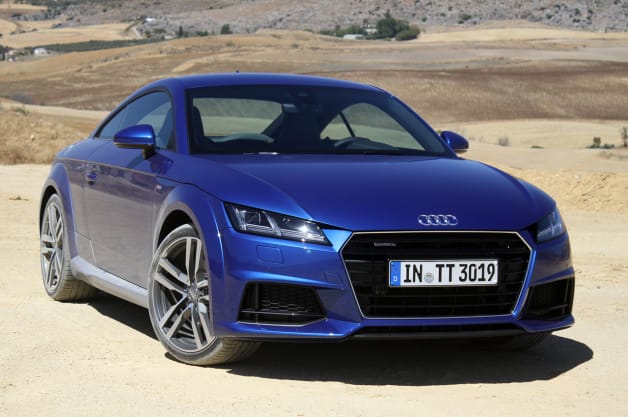
What came first, the metrosexual or the Audi TT? While it was close, the
descriptor-turned-epithet preceded the 1995 concept car by one year. However,
they were both notable cultural evolutions and they happened to work together
perfectly. Hugh Grant, playing the cad Will Freeman in the 2002 film About a Boy, could not have
chosen a better example of character than his silver TT.
A decade later, the original TT was still important enough that when rumors of the third-generation coupe began to surface in late 2012, the most exciting fantasy was that the 2014 coupe might "recapture some of the distinctiveness and impact" of a 16-year-old car (the TT came to market in 1998). Even speculation by dedicated Audi observers thought the brand would do something novel, even if not mimicry. The obvious takeaway: no one was going to be lighting any candles for the departed second generation. All of that is why when the first leaked image slipped onto the Internet, people began to get suspicious. When the third generation took the stage at theGeneva Motor Show, we could almost hear the digital deflation over the Ethernet, our poll results notwithstanding.
Yet it's still the TT, and in spite of having seen its interior and virtual cockpit and clocked its specs, we couldn't judge it before heading to Marbella, Spain to drive it. What we found out was while it's better than the second generation, it's still very much a TT.
A decade later, the original TT was still important enough that when rumors of the third-generation coupe began to surface in late 2012, the most exciting fantasy was that the 2014 coupe might "recapture some of the distinctiveness and impact" of a 16-year-old car (the TT came to market in 1998). Even speculation by dedicated Audi observers thought the brand would do something novel, even if not mimicry. The obvious takeaway: no one was going to be lighting any candles for the departed second generation. All of that is why when the first leaked image slipped onto the Internet, people began to get suspicious. When the third generation took the stage at theGeneva Motor Show, we could almost hear the digital deflation over the Ethernet, our poll results notwithstanding.
Yet it's still the TT, and in spite of having seen its interior and virtual cockpit and clocked its specs, we couldn't judge it before heading to Marbella, Spain to drive it. What we found out was while it's better than the second generation, it's still very much a TT.
It's fair to say that the new car hasn't been
comprehensively reconceived; it's been comprehensively re-detailed.
We need to start off by giving Audi some proper credit: it
massively upgraded the handling of the TT with the second generation. That
original had the looks, but its progeny had the liveliness that got positively
lusty in the TT-RS. In a
dream, the third generation would frappé that heritage into the best of all
worlds.
Despite its new platform, it's fair to say that the new car hasn't been comprehensively reconceived; it's been comprehensively re-detailed. You have to look at the current car next to the new one to see how big the differences are, but once you see them, it's clear how many changes have been made, and how much first-gen has returned to the bodywork. (Bodywork that was inadvertently harangued by the dusty Spanish roads, as you can see. Our earnest apologies.)
The coupe is the same height as before, yet it's 0.4 inches narrower and 0.8 inches shorter. The wheelbase, extended by 1.5 inches, means shorter overhangs. In front, curves are replaced by beveled edges that support the large, single-frame grille; that and the four rings on the hood are meant to invoke the R8, while the twin vertical struts that form the LED daytime running lamp signature are meant to recall the R18 e-tron Quattro racecar. The wheel arches, which Audi calls "superimposed," have sharper edges and are connected by a prominent, jutting sill, both trademarks of the original TT.

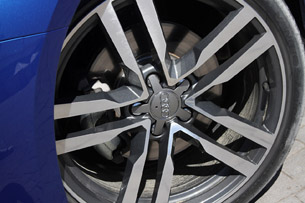
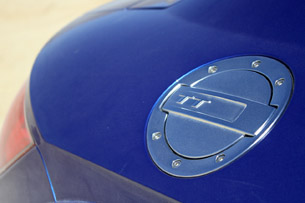
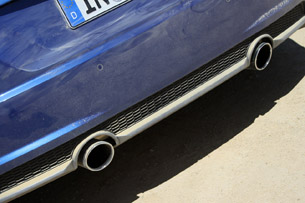
Despite its new platform, it's fair to say that the new car hasn't been comprehensively reconceived; it's been comprehensively re-detailed. You have to look at the current car next to the new one to see how big the differences are, but once you see them, it's clear how many changes have been made, and how much first-gen has returned to the bodywork. (Bodywork that was inadvertently harangued by the dusty Spanish roads, as you can see. Our earnest apologies.)
The coupe is the same height as before, yet it's 0.4 inches narrower and 0.8 inches shorter. The wheelbase, extended by 1.5 inches, means shorter overhangs. In front, curves are replaced by beveled edges that support the large, single-frame grille; that and the four rings on the hood are meant to invoke the R8, while the twin vertical struts that form the LED daytime running lamp signature are meant to recall the R18 e-tron Quattro racecar. The wheel arches, which Audi calls "superimposed," have sharper edges and are connected by a prominent, jutting sill, both trademarks of the original TT.




With the 2.0-liter TFSI four-cylinder and a six-speed
manual, curb weight is said to be 2,712 pounds.
In back, geometry reasserts itself, with sharper lines
framing the rear decklid. The LED taillights are tied together by a full-width,
high-mounted brake light, defining the shape of a bumper. Beneath it all, the
tailpipes have moved closer together – yet another tip of the hat to the
original car. Another tech note: the TT makes the switch to capless fuel
filling underneath that classic silver door. It's certainly good looking, and
when you take time to notice the surfacing, you can appreciate its evolution,
but our esteem is more philosophical than visceral.
We won't get the car for another year, so we don't have US weight specs yet, but the European version sits lighter on the ground than before. That's thanks to a slimming regimen that includes a new design for its aluminum and steel composite spaceframe, the seats and wheels. With the 2.0-liter TFSI four-cylinder and a six-speed manual, curb weight is said to be 2,712 pounds – in official words that's "up to 110.2 lbs less than before." Sure, that's less than the 220-pound weight loss for the MkVII Volkswagen Golf that shares its platform, but comparing Euro to Euro, the TT is still 312 pounds lighter.
That engine is the same one we'll get, a turbocharged, torque-happy puller with 230 horsepower and 273 pound-feet of twist, meaning 19 more stallions and 14 more lb-ft than before. Internal refinements like indirect injection on top of direct injection (depending on operating conditions), the addition of stop/start and having to motivate a lighter car means fuel economy will go up; Audi reports 36.8 miles per gallon combined on the European cycle, we'll get US numbers next year.
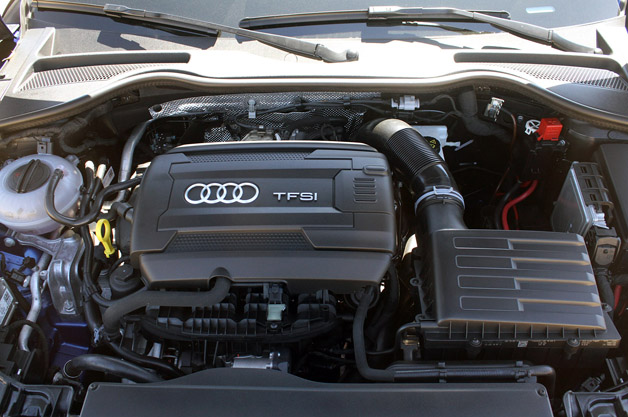
We won't get the car for another year, so we don't have US weight specs yet, but the European version sits lighter on the ground than before. That's thanks to a slimming regimen that includes a new design for its aluminum and steel composite spaceframe, the seats and wheels. With the 2.0-liter TFSI four-cylinder and a six-speed manual, curb weight is said to be 2,712 pounds – in official words that's "up to 110.2 lbs less than before." Sure, that's less than the 220-pound weight loss for the MkVII Volkswagen Golf that shares its platform, but comparing Euro to Euro, the TT is still 312 pounds lighter.
That engine is the same one we'll get, a turbocharged, torque-happy puller with 230 horsepower and 273 pound-feet of twist, meaning 19 more stallions and 14 more lb-ft than before. Internal refinements like indirect injection on top of direct injection (depending on operating conditions), the addition of stop/start and having to motivate a lighter car means fuel economy will go up; Audi reports 36.8 miles per gallon combined on the European cycle, we'll get US numbers next year.

Audi reports 36.8 miles per gallon combined on the European
cycle.
It's the interior that gets marquee billing this time
around, and it's arguably even nicer to experience in the car than on the show
floor display we studied at CES.
The integrated climate controls are a cinch to operate and always stay centered
– twisting the vent bezel rotates the inner turbine blades to alter the
direction of air, not the vent. The refined MultiMedia Interface (MMI) controls
have gone from four buttons to two toggle switches astride the large knob; you
can flip between navigation, telephone, radio and media without ever having to
look down. The surface of the MMI knob is touch sensitive and responds to
finger gestures including writing characters and pinch zooming. And,
hallelujah, the new TT is the first with Audi's new scrolling action, which
works like it does on every other car on the planet: rotate to the right to
scroll down, to the left to scroll up.
A 12.3-inch screen acts as a gauge cluster – and it has curved edges, it's not a rectangular plinth – is bright and never washed out even under the exceedingly luminous Spanish sun. The display can show a prominent speedometer and tachometer at the edges, about the sizes of the current analog gauges, with other infotainment menus appearing in between, or you can shrink the gauges to focus on something else like the navigation map (scroll down to see this all in our short video). Folks who wonder if the passenger is stranded in an information-free zone needn't worry; from the shotgun seat, you can clearly see everything but a small corner of the screen, and you can grab the MMI control to adjust things as you please. Will that annoy the driver? We didn't think so, but in our experience, the passenger only changed things when we expected it, so we weren't bothered about what was happening in the cluster.
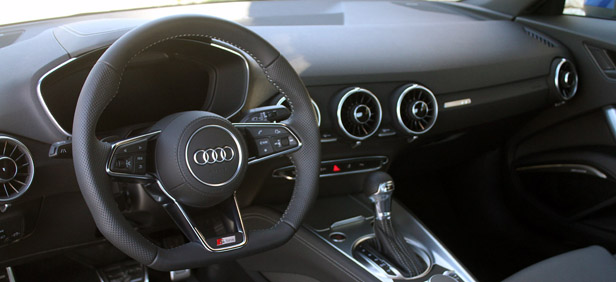


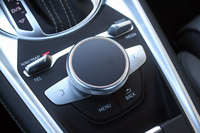
A 12.3-inch screen acts as a gauge cluster – and it has curved edges, it's not a rectangular plinth – is bright and never washed out even under the exceedingly luminous Spanish sun. The display can show a prominent speedometer and tachometer at the edges, about the sizes of the current analog gauges, with other infotainment menus appearing in between, or you can shrink the gauges to focus on something else like the navigation map (scroll down to see this all in our short video). Folks who wonder if the passenger is stranded in an information-free zone needn't worry; from the shotgun seat, you can clearly see everything but a small corner of the screen, and you can grab the MMI control to adjust things as you please. Will that annoy the driver? We didn't think so, but in our experience, the passenger only changed things when we expected it, so we weren't bothered about what was happening in the cluster.




The only knock we can give the interior is the large expanse
of instrument panel presented to the passenger.
The only knock we can give the interior is the large expanse
of instrument panel presented to the passenger. It's a long way from the IP's
front edge to the bottom of the steeply raked windshield, and even though the
seats are mounted lower in the chassis, you've got to look over that beach of
black plastic to see the outside world. On the TTS, it's partially overlaid
with a pebbled surface that slightly ameliorates the vision, but we'd wish for
some kind of design feature or ornamentation to break it up further.
We have no complaints about the way this new TT drives, though. All of the sharpening and intensifying and recombining that's gone into making this coupe a sportier drive just works. The changes don't revolutionize the TT or make it an all-out sports car, but they are definitely effective – the new model has better reflexes than the current car. Part of that is because of the updated Quattro system, re-engineered to send power to the rear wheels sooner and more often for better turn-in. On top of that, the lighter electrohydraulic multi-plate clutch actuation is now tied into the various user-selectable Drive Select modes, making it more proactive by taking things like steering angle into account, and better prepared for dynamic management of handling aids like torque vectoring.
We have no complaints about the way this new TT drives, though. All of the sharpening and intensifying and recombining that's gone into making this coupe a sportier drive just works. The changes don't revolutionize the TT or make it an all-out sports car, but they are definitely effective – the new model has better reflexes than the current car. Part of that is because of the updated Quattro system, re-engineered to send power to the rear wheels sooner and more often for better turn-in. On top of that, the lighter electrohydraulic multi-plate clutch actuation is now tied into the various user-selectable Drive Select modes, making it more proactive by taking things like steering angle into account, and better prepared for dynamic management of handling aids like torque vectoring.
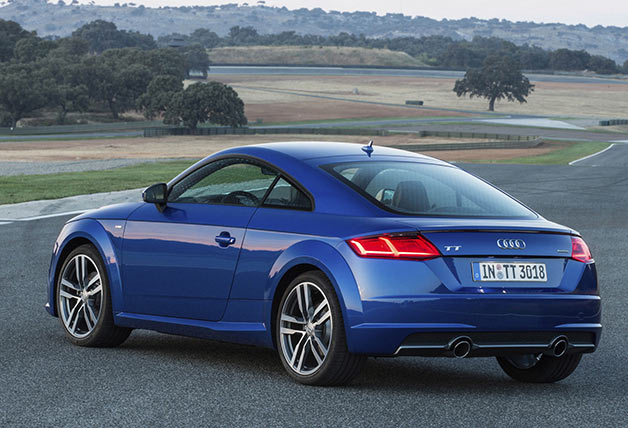
The soundtrack is just like the heinously more expensive
Porsche 911 Turbo S.
Unless you like terrifically light controls, put the Drive
Mode setting into Dynamic, wait the fraction of a second for the steering and
accelerator feedback to firm up, and enjoy. The bodyshell is 23-percent stiffer
torsionally and the magnetic dampers allow it to do its job without harshness
even over unkind roads. Press on, and with all 273 pound-feet available from
just 1,750 rpm, a willing Sport mode switched on and paddle shifters at the
ready, the TT is absolutely unafraid to tackle any curvy road, even up a
Spanish mountain. The six-speed S-tronic dual-clutch gearbox delivers the
expected instantaneous shifts and does so accompanied by a soundtrack just like
the heinously more expensive Porsche 911 Turbo S. Wind noise is negligible,
although its absence gives one more chance to hear the work being done by the
adaptive sound actuator. Audi calls it "sonorous" in Dynamic mode, we
think it has a tendency to drone and in any case would rather it be called
"burbly."
Press on even harder and yes, understeer pops in for a visit, but not before you get some proper laterally inclined driving sensations like a slight drift. You have to be doing something dunderheaded for the nose to just plow on.
And that's the thing about this new TT: it's probably 94 percent different than the outgoing car – Audi says everything about the 2.0 TSFI engine has changed except its capacity – but outside and in, it only feels about 40-percent different, and you've got to stop and stare to notice all of the changes outside.
We kept thinking while driving the car, "It is, capital 'P' capital 'F,' Perfectly Fine."
Press on even harder and yes, understeer pops in for a visit, but not before you get some proper laterally inclined driving sensations like a slight drift. You have to be doing something dunderheaded for the nose to just plow on.
And that's the thing about this new TT: it's probably 94 percent different than the outgoing car – Audi says everything about the 2.0 TSFI engine has changed except its capacity – but outside and in, it only feels about 40-percent different, and you've got to stop and stare to notice all of the changes outside.
We kept thinking while driving the car, "It is, capital 'P' capital 'F,' Perfectly Fine."
It's not such a big seller here anymore – they've sold just
1,056 as of the end of August – but it's still big overseas and we're not
surprised as to why. It handles, it makes a much different, shall we say more
'masculine,' statement than a BMW
Z4 (also a slow seller here) or a Mercedes-Benz SLK (still popular, in
fact), plus it's 9,000 euros less than a Porsche Boxster and it's available
with a torquey diesel engine, great gas mileage and a six-speed manual.
In a US context, though, all we kept thinking while driving the car was, "It is, capital 'P' capital 'F,' Perfectly Fine." It's fun to push, we dig the interior and hope more cars get similarly de-cluttered, it's got Audi build quality and superb Audi detailing going for it, but it arguably doesn't make much of a statement anymore – "Less expensive than a Boxster" might be the strongest one it's got... only the Boxster has sold 2,749 units through the end of August this year.
What your author came up with when the drive was over wasn't a statement, but a question: "Why doesn't Audi let this go and find a way to give us the R4?"
In a US context, though, all we kept thinking while driving the car was, "It is, capital 'P' capital 'F,' Perfectly Fine." It's fun to push, we dig the interior and hope more cars get similarly de-cluttered, it's got Audi build quality and superb Audi detailing going for it, but it arguably doesn't make much of a statement anymore – "Less expensive than a Boxster" might be the strongest one it's got... only the Boxster has sold 2,749 units through the end of August this year.
What your author came up with when the drive was over wasn't a statement, but a question: "Why doesn't Audi let this go and find a way to give us the R4?"
source: Autoblog
by Jonathon Ramsey
Image Credit: Copyright 2014 Jonathon Ramsey / AOL | Audi
http://www.boscheuropean.com
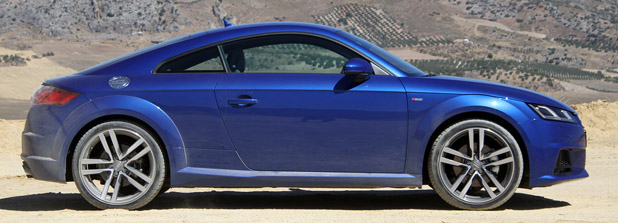
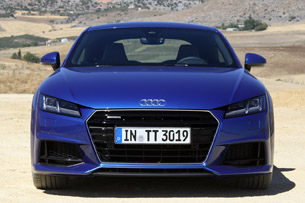
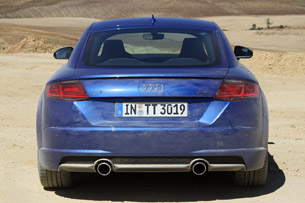
No comments:
Post a Comment